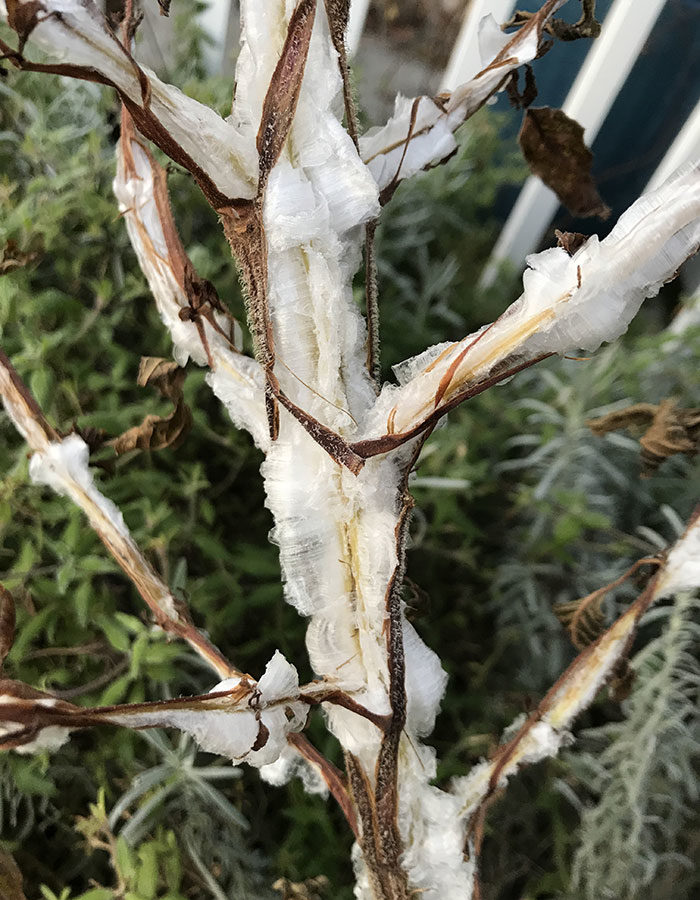
“Aesthetics of decay” might sound like an exhibit at a modern art museum. But seasoned gardeners know there is something special about how a garden returns to itself in the winter. In the South, this merely means that gardens rest for a moment to catch their breath before boomeranging back to life in the spring. As December dawns in the garden, we reach the opening act of a show we need to be observant and patient to appreciate. Don’t worry—spring ephemerals will soon be under foot. For now, as the weather cools, take a minute to appreciate plants in their winter form.

The first frost transforms the garden
As the moisture in the atmosphere contacts a surface with a temperature below 32°F, frost is formed. In the South, we often have very light frosts in late fall that damage our most tender annuals and coat our lawns with crystalline tips. These frosts are the prelude to the season’s first “real” frost, as it is often called. This frost is a shift in momentum, signaling that the warm-weather growing season is over, although some gardeners may still have cool-season vegetables to harvest at this time. Take a moment on the day of your first real frost to appreciate the forms of plants as they give way to the cold. It can be a truly spectacular sight.

Seed heads left standing provide structure after flowers have faded
The hedgehog-like seed heads of purple coneflower (Echinacea purpurea and cvs., Zones 3–8) flutter with activity after first frost as goldfinches race to clean them of every precious seed. Milkweed (Asclepias spp. and cvs., Zones 3–9) burst open the curtains of their cracking pods, allowing their seeds to catch on cooler winds. In the early part of winter when seed heads are still ever-present in the garden, collect any remaining seeds that you might wish to sow in the spring. But most of all, appreciate the different forms that seed heads and seedpods take in your garden.

Bark provides much-needed texture in a winter landscape
So much attention is paid to the glory of spring and the colors of autumn that a healthy appreciation for bark may be overlooked. Appreciating plants for their bark is like tapping into a gardening sense you never knew you had. There are many fascinating plants we can grow in the South that stand out in colder months for their unique or colorful bark. After the raking is done for the year, take a walk around your garden and make sure you have at least one thing in your landscape that you value for this reason. The ubiquitous crape myrtle (Lagerstroemia spp. and cvs., Zones 6–9) is a great place to start. Other great standouts include kousa dogwood (Cornus kousa, Zones 5–8), paperbark maple (Acer griseum, Zones 4–8), smooth cypress (Cupressus arizonica var. glabra, Zones 7–9), Japanese cornel dogwood (Cornus officinalis, Zones 5–8), and FOX VALLEY® dwarf river birch (Betula nigra ‘Little King’, Zones 4–9).

Grasses look gorgeous covered in snow or ice
Fall is prime time for ornamental grasses. However, as colder weather approaches there is still a role for grasses in the garden. They continue to provide movement and structure in the landscape. Don’t be too quick to cut back these beauties. Beneficial insects, birds, and others may be taking shelter among their plumes. Additionally, most ornamental grasses are warm-season grasses, and avoiding cutting them back is a way to provide winter protection. Little bluestem (Schizachyium scoparium, Zones 3–9), which brilliantly catches the lightest flake of snow on its seed heads, has always been one of my winter favorites.
(For more information on grasses in the South, see my previous regional report.)

Look out the window and plan ahead
Many gardeners spend an enormous amount of energy worrying about what their garden looks like from the curb. When the cold sets in, take stock of your garden, but not just from the curb to the front door. Grab a warm drink, and peer out from your interior windows. How many interesting things do you see? Contemplate what suits your style, and perhaps incorporate something new into your winter garden.
—Andy Pulte is a faculty member in the plant sciences department at the University of Tennessee.
Fine Gardening Recommended Products

Scotts Cordless Grass-Shear/Shrub-Trimmer Combo

Black and Decker 22-inch Cordless Hedge Trimmer

DeWalt Variable-Speed Cordless Reciprocating Saw


















Comments
Log in or create an account to post a comment.
Sign up Log in